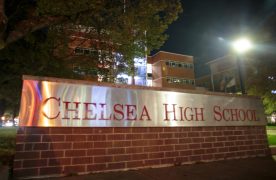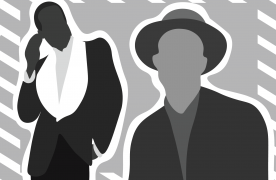Their workplace virtually hidden in a maze of The Boston Globe’s offices, their projects unknown to even many in the newsroom, a small team of journalists is solely responsible for bringing scrutiny and turmoil to one of the world’s oldest and most powerful institutions. After publishing the first story just over a year ago, The Boston Globe Spotlight Team’s exposure of the sexual abuse and cover-up scandal within the Catholic Church has spread far beyond Boston, shocking even the Vatican with its revelations.
Walter V. Robinson, a 28-year veteran Globe journalist, is editor of the Spotlight Team and assistant managing editor of the Globe. His history with the newspaper includes covering four presidential campaigns, the Persian Gulf War and holding 18 different positions at the Globe, including Statehouse and City Hall bureau chief, Middle East bureau chief, city editor and metro editor. Since months before the first clergy abuse story broke on Jan. 6, 2002, Robinson has led the Spotlight Team through its investigation into the Church, revealing evidence that has linked 111 priests to records of abuse.
‘Most people here now believe [the Church scandal] is the most important story the newspaper has ever done,’ Robinson said. ‘There’s really nothing that approaches it in terms of the extent of the coverage and the impact that we’ve had.’
Although the modest editor insists ‘most people have no idea who we are,’ the Spotlight Team and other Globe reporters have published more than 800 articles on the subject since the story broke.
Investigative reporting for the Spotlight Team, he explained, did not differ much from his previous positions.
‘All good reporters dig,’ he said. ‘So to call one group investigative reporters and another just reporters is a little misleading.’
The team’s efforts earned them the Associated Press Managing Editors Freedom of Information Award in October, and many speculate a 2003 Pulitzer is next in line.
Created more than three decades ago, the Spotlight Team originally included only three or four reporters, and has always operated in ‘secret quarters’ within the Globe building, Robinson explained. Only senior editors and the spotlight reporters’ spouses knew what projects the team was investigating, he said.
The team, now composed of seven members, began its clergy investigation in June 2001, after Cardinal Bernard F. Law, then archbishop of Boston, filed a court document admitting to having approved Rev. John J. Geoghan for ministry in 1984, despite his knowledge that the priest was an alleged child molester. Robinson said it was then that the Spotlight Team began questioning the extent of the problem.
‘I recall thinking at the time, ‘My god, what if there were 12 or 15 priests who had abused kids?” he said. ‘Every time these cases crop up, the Church very effectively argues that these were isolated incidents and that the press was overreacting.’
The team began its examination by going to court to seek other documents proving the alleged abuse or revealing further clergy misbehavior and filed a motion in August to lift the confidentiality order that had kept the court documents from public view. Superior Court Judge Constance M. Sweeney supported the newspaper, and after the Church’s unsuccessful appeal, the documents became public in Jan. 2002.
In addition to sorting through public court files as well as the 30 cases filed by victims’ families and allegedly covered-up by the Church, the then eight-member team began the tedious task of searching through the archdiocese’s annual directories for further guilty priests, Robinson said. Creating a database, they entered every priest listed as ‘unassigned’ or on ‘health leave,’ and began to investigate him further.
From this research, the team revealed in a Jan. 2002 article that more than 70 priests were involved in ‘secret settlements,’ in which the Church offered the alleged victims financial compensation for keeping quiet about their abuse cases. The victims’ attorneys even referred to the payments as ‘hush money,’ Robinson said.
The team found a total of 111 priests with records of abuse, 83 of which have been made public. Many cases were discovered through the more than 300 alleged victims who called a Globe tip line to expose their alleged abusers.
‘We got flooded with calls,’ Robinson said. ‘People who started to come forward contacted lawyers, [who] then sued the Archdiocese.’
The vast majority of calls from alleged victims proved genuine, Robinson said.
‘The incidents of people making false claims is tiny,’ he said. ‘People when they share with you something like that there’s an emotional honesty to it that is hard to fake.’
The latest estimation of the number of priests released from their ministry across the nation due to accusations of abuse is more than 450, said Robinson, who believes the abuse would still go unnoticed without the Globe’s report of the situation and the court decision granting the newspaper freedom to access documents.
Spotlight reporter Sacha Pfeiffer believes the Church investigation fulfills the purpose of the Spotlight section.
‘It was a project that truly did what Spotlight is supposed to do, which is root out corruption,’ she said.
But instead of finding mismanagement in Spotlight’s characteristic arenas politics, law enforcement or municipal government this project exposed corruption in what Pfeiffer calls an ‘unconventional institution.’ That’s why it hit home to so many citizens within the Boston Archdiocese and around the globe, she said.
‘We knew this was going to be a huge local story,’ Robinson said, ‘[but] we had no idea that it would reach the Vatican.’
Robinson said he was surprised by the initial reaction of the public to his team’s revelations, saying he’d envisioned ‘hundreds of Catholics picketing the Globe.’ But despite parishioners’ shock and disbelief, the fact that most of the information came from the church’s files bolstered the team’s credibility, he said.
‘Because we were relying on the church’s own documents to tell the story, … people began to [realize] this is a serious issue,’ he said. ‘With so many disclosures now, people know the hierarchy of the church has been pretty corrupt.’
Having attended Catholic school for 12 years, Robinson said much of his religious knowledge helped in his investigation.
‘The intensity of the reporting on this and the amount of contacting we have with people in the Church is certainly an occasion that forces you to reflect more about your own faith,’ he said. ‘You can’t get this involved in this kind of a subject without spending a fair amount of time thinking about the Church and institutions.’
Pfeiffer agrees. Like six of the other Spotlight reporters who were raised in at least partially Catholic households, she believes her background provided an added insight into the project. Her mother, a devout Catholic, initially struggled with her involvement, but soon realized the necessity of her reporting, she said.
‘It was tough for her to see her daughter involved in this project,’ Pfeiffer said, ‘but I think she also realizes that a terrible thing happened and it needed to be written about.’
During the height of the Church investigation last spring, the Globe decided that the Spotlight Team should write a book detailing the crisis. After a month of writing and a week of editing, ‘Betrayal: The Crisis in the Catholic Church’ hit bookstores in June 2002, having been published in remarkable time, Robinson said. Writing of the nine chapters was divvied up among Spotlight reporters.
Though Robinson would not profess a firm opinion separate from that of the Globe’s Editorial staff, he expressed surprise that Cardinal Law kept his position as archbishop for so long throughout the scandal, before his resignation on Dec. 13, 2002.
‘There is not a political institution, which is accountable to the voters and the people, where the leader would have lasted a week given the disclosures,’ he said.
Pfeiffer stressed the importance of these disclosures.
‘I always tell people that it renewed my sense of outrage,’ she said. ‘A really horrendous thing happened, and it’s long overdue for it to be exposed.’
With some self-proclaimed experts describing it as the beginning of a second Reformation, according to Robinson, the crisis in the Catholic Church is certainly not nearing its end. Accountability of both the sexual abusers and the hierarchy of the Church that protected them is due to the 65 million Catholics in the United States, he said.
‘For years to come, this is going to be a very big story here,’ he said.
This is an account occasionally used by the Daily Free Press editors to post archived posts from previous iterations of the site or otherwise for special circumstance publications. See authorship info on the byline at the top of the page.












